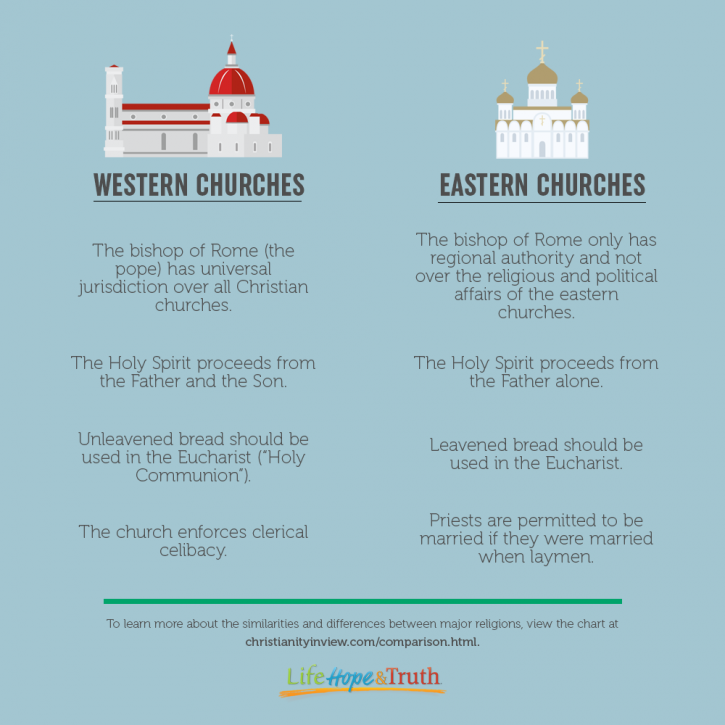What’s Behind Pope Francis’ Ecumenical Efforts?
Pope Francis has been transforming the tone and approach of the Catholic Church. What’s behind his ecumenical overtures to other churches?
Pope Francis embraces the president of the Lutheran World Federation during his trip to Sweden to mark the 500th anniversary of the Protestant Reformation.
But to understand the significance of Pope Francis’ ecumenical efforts, we need to understand why these churches split from the Catholic Church in the first place.
East-West schism
The rupture between eastern and western Christendom, the Great Schism, occurred in 1054. This split caused churches in the Eastern Roman empire to separate from the Western Church, centered in Rome.
On July 16, 1054, representatives of Pope Leo IX strode into the Hagia Sophia (in what is now Istanbul, Turkey) and placed on the main altar a parchment officially excommunicating the patriarch of Constantinople, Michael Cerularius. They then shook the dust off their feet and left the city. A week later the patriarch responded by excommunicating the pope.
There wasn’t a single event that caused the schism; the differences between the churches grew over centuries, culminating in the excommunications of 1054. Here are some of the major differences in teachings that led to the split:

Pope Francis has certainly continued the efforts for greater reconciliation with the Orthodox churches. Consider these headlines: This state of division lasted for about 911 years, until the Catholic-Orthodox Joint Declaration of 1965 was adopted. The excommunications were lifted, and the two sides resolved to work together toward greater reconciliation.
- May 2014: Pope and Patriarch at Prayer Marks Historic Chapter in Ecumenism.
- November 2014: Francis and Bartholomew Issue Resounding, Historic Calls for Church Reunification.
- May 2015: Pope Francis to Pope Tawadros: Ecumenism of Blood Unites Us.
- January 2016: Pope Francis at Ecumenical Vespers: Walk the Way of Unity.
- April 2016: Pope Francis, Patriarch Bartholomew, and Archbishop Ieronymos Sign Joint Declaration in Lesbos.
- June 2016: Mercy Unites Catholic and Orthodox Churches, Pope Francis Says.
Protestant split
In 1517 Martin Luther, an Augustinian monk from Germany, penned a document known as his “95 Theses,” protesting the corruptions in the Catholic Church. Some of Luther’s doctrinal differences with the Catholic Church included:
- The doctrine that we are saved by grace alone (Catholic works are not needed).
- The Bible alone should be the source of beliefs.
- Rejection of the pope’s authority.
Luther was the first of many reformers who would break from the Catholic Church. Since the 16th century, Protestants have continued to protest among themselves and splinter into thousands of denominations. But in recent decades many denominations have begun to deemphasize doctrinal differences and focus more on feelings and experiences. Few Christians today see as sharp differences between Protestants and Catholics as Martin Luther did 500 years ago.
Pope Francis has also made great efforts to reach out to Protestants. He has recognized Protestant churches as valid paths to salvation, calling Protestants “separated brothers.” His efforts have included the following headlines:
- February 2014: Pope Francis to Separated Brothers: “We Must Cry Together.”
- June 2014: Joel Osteen, in the Spirit of Ecumenism, Meets Pope Francis.
- July 2014: Pope Francis Apologizes for Persecution of Pentecostals.
- October 2014: In New Video, Francis Urges Catholics and Protestants to Work Together.
- January 2016: Pope Francis at Ecumenical Vespers: Walk the Way of Unity.
- August 2016: US Lutherans Approve Document Recognizing Agreement With Catholic Church.
- October 2016: In Show of Unity, Pope Francis Marks 500th Anniversary of Protestant Reformation.
Other forms of ecumenism
Pope Francis’ ecumenism has not been limited to Christianity. He is also considered the most ecumenical pope in history because of his efforts in support of the environment, combating extremism, humanitarianism and uniting other faiths.
- July 2013: “If a Gay Person Seeks God, Who Am I to Judge Him?” Says Pope Francis.
- September 2013: Pope Francis Assures Atheists: You Don’t Have to Believe in God to Go to Heaven.
- September 2015: Pope Francis Blends Environmental, Ecumenical Agendas in Day of Prayer.
- January 2016: In First Prayer Video, Pope Stresses Interfaith Unity: “We Are All Children of God.”
- January 2016: Pope Visits Rome’s Great Synagogue: You Are Our “Elder Brothers.”
- May 2016: Pope Francis and Top Sunni Leader Meet at the Vatican.
- November 2016: Grand Mufti Meets Pope Francis for Conference on Commonalities in Religions.
- November 2016: Pope Francis Calls on Religions to Condemn Acts of Terrorism, Violence.
Prophetic significance
Many may see these as all positive steps toward different groups coming together. But it’s important to see what the Bible says.
It prophesies that just before Jesus Christ returns, two great leaders will arise on the world scene. One is known as the “beast” (a political leader rising out of Europe) and the other as the “false prophet” (a charismatic religious leader). These two men will work together to deceive the nations (Revelation 16:13-14). This involves a false religion that will be worshipped around the world (Revelation 13:8). The book of Revelation indicates the religious leader will arise from Rome (Revelation 17:1-9). This is why Pope Francis’ ecumenical moves are prophetically significant.
Is Pope Francis, through his gentle and conciliatory approach, trying to bring Rome’s daughters back home?
This great false church is identified as a “mother of harlots” (Revelation 17:5)—indicating that she is a church who considers herself a mother over “daughter” churches. The Catholic Church not only describes itself as “the mother” of Christianity, but also has given birth to numerous “daughter” churches—including the Orthodox and Protestants. Both trace their roots back to Rome. Is Pope Francis, through his gentle and conciliatory approach, trying to bring Rome’s daughters back home?
God’s faithful followers must hold faithfully to the Word of God (Revelation 13:8). The Bible also warns that this future religious leader will perform “great signs and wonders” that could potentially deceive God’s people (Matthew 24:24). Watch these ecumenical movements and “take heed that you not be deceived” (Luke 21:8).
For further insight into end-time events involving the Catholic Church, read:
Date Posted: November 28, 2016

 by Isaac Khalil
by Isaac Khalil

